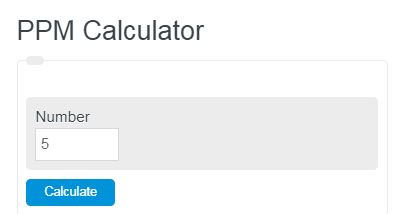Enter any given number, or value, to calculate the following values; ppm, ppb, ppt, permille, and percentage.
- Proportion Calculator
- Scale Calculator
- BPS Calculator (Basis Points Calculator)
- PPM to Molarity Calculator
- MCG to PPM Calculator
- BOD Load Calculator
PPM Formula
The following formulas are used to calculate PPM and other values.
- PPM = X * 1,000,000
- PPB = X * 1,000,000,000
- PPT = X * 1,000,000,000,000
- Permille= 1* 1,000
- Percentage = 1*100
To calculate PPM, multiply the value by 1 million (1,000,000). To calculate the PPB, multiply the value by 1 billion. To calculate the PPT, multiply the value by 1 trillion.
PPM Definition
PPM is short for parts per million, which is exactly as it sounds. It’s a faction per million units of some number or value.
For instance, if you have .00005 atoms of oxygen per cubic meter of air, that means that in 1 million cubic meters you have 50 atoms per million units.
How to calculate PPM
First, you must determine the number you wish you calculate the parts per million of. Most often this is a number of atoms in some unit of volume or solution.
For example, the number of carbon atoms per amount of soil.
Second, multiply the number you got in step one by 1,000,000.
This can be done using the calculator above, or it can be done using a standard calculator or hand calculation.
Finally, you need to analyze the results.
PPM is used to bring a really small number into a more realistic number that you can visualize and analyze. For instance, if your number is still low, switch to parts per billion and so on.

Parts-per Notation
PPM is one of a set of dimensionless units used to describe small numbers, as stated above.
The others PPB, PPT, and even PPQ (parts per quadrillion) are also part of this notation, often referred to as parts-per notation.
Although these units are dimensionless, the notation itself is recognized as part of the SI system of units.
The most common use for parts-per notation is in chemistry. It’s used to both describe and explain the abundance of materials in a solution.
Another common use is in environmental engineering. It’s used to describe the number of dissolved pollutants in water. For example, the number of lead atoms per gram of water is then multiplied by 1,000,000.
Parts-Per notation isn’t just used in use in chemistry, it’s also used in physics. Its use in physics is tied to proportional values or phenomena.
That is, 1 micrometer per some unit can be expressed as a PPM of a meter since a micrometer is 1m/1,000,000.

